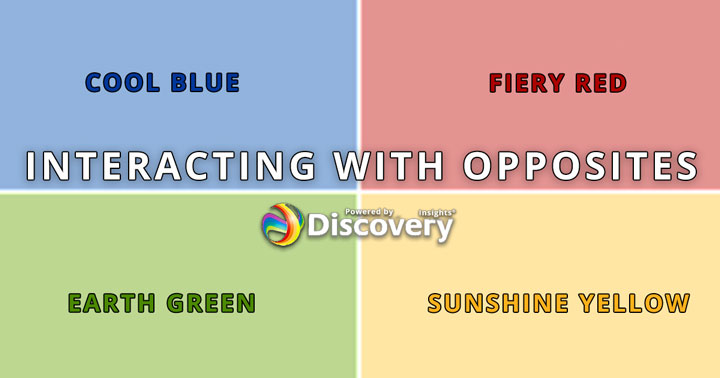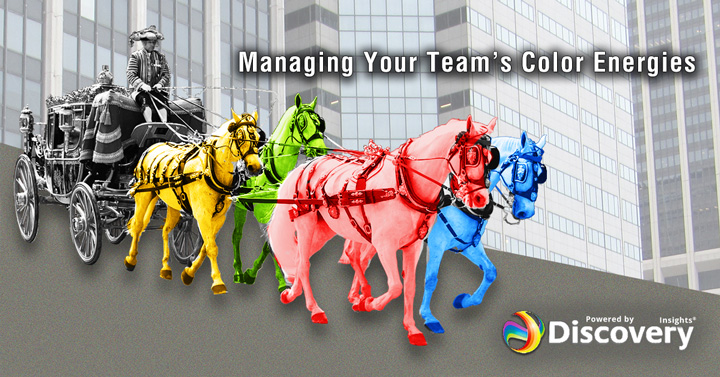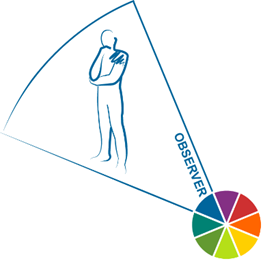Interacting With Our Opposite Types

Personality assessments are useful not only for participants to understand themselves better, but also to understand the other people around them. Interacting with people with very different views and priorities can be challenging, but Insights Discovery can suggest ways for interacting with our opposite types in order to work together more smoothly and effectively.
Interacting With Our Opposite Types By Color Energy
Fiery Red Interacting with Earth Green
Fiery reds are action driven, confident, and focused on their goals. Their opposite type are earth greens, who are calm, supportive, and ethical. A fiery red can see earth greens as docile, inactive, resistant, or stubborn. The methodical, careful progress of the earth green can feel frustrating and plodding to the active fiery red type.
To get the most from interactions with earth greens and to avoid losing their temper, fiery reds should practice patience and try to hold back from jumping in to every task head first. There can be great value in pausing to think an idea through before getting caught up in the action, and earth green can help to provide this balance.
A skill that earth greens can offer to fiery reds is the ability to see other’s points of view and to foster consensus. While a fiery red would likely try to resolve a dispute between members by imposing a rule or view onto the whole team, an earth green will try to find a compromise where everyone is happy and where every member of the team feels respected.
As fiery reds are often natural leaders, they motivate and push their team to achieve more. But they also benefit greatly from having an earth green as a fellow manager who can soothe team members and support them when they are stressed. Fiery reds should learn to see the value in this more caring, empathetic approach and learn when to deploy an earth green to smooth over difficult social situations.
Earth Green Interacting with Fiery Red
The patient and caring earth greens can find the forward and assertive fiery red type to be aggressive, controlling, and overbearing. The tendency of fiery reds to take charge and to push others towards goals can chafe the earth green who wants everyone to feel respected and understood. It will help earth greens to remember that democratic relationships are indeed important, but sometimes it is necessary for someone to lead decisively.
If an earth green feels like they or others are being steamrolled by the fiery red, then they can try raising these concerns outside of a high-pressure group meeting situation. A fiery red will be much more receptive if the earth green can voice their issues in terms of impediments to action as opposed to personal feelings.
An earth green can benefit from the push that a fiery red provides, as this can prevent them from overthinking and compel them to action. Also, there may be situations where it is not possible for everyone to be happy, and a fiery red will push for an acceptable solution where an earth green can be paralyzed by indecision.
Sunshine Yellow Interacting with Cool Blue
Sunshine yellows are sociable, creative, and love to dream about the future. Their opposite type is cool blues, who are methodical, analytical, and precise. Sunshine yellows can perceive cool blues to be cold and reserved, and find it strange that they are more focused on rules or data than on people.
To a highly people-focused sunshine yellow, it may be almost inconceivable that anyone would not think primarily in terms of social interactions. Therefore, when interacting with cool blues, it can help sunshine yellows to remember that focusing on data over interpersonal relations does not mean a lack of care for other people – rather, cool blues want to be fair to all people, and they express that care in a data-driven way.
A cool blue can make a strong partnership with a sunshine yellow. The sunshine yellow person can imagine great concepts for the future and raise enthusiasm for the project among other people, while the cool blue can come up with the realistic ways to achieve those concepts in the real world.
The pragmatism of a cool blue can be an essential reality check on the dreamy nature of a sunshine yellow, as long as the sunshine yellow doesn’t take this pragmatism personally. They should remember that when a cool blue expresses skepticism about an idea, they are not trying to be negative – they are searching for a way that the idea can realistically be achieved.
Cool Blue Interacting with Sunshine Yellow
Conversely, when analytical and logical cool blues have to interact with excitable and dynamic sunshine yellows, they can find them to be hasty and imprudent, or even disorganized and a “head in the clouds” type. It will help cool blues to remember that, unlike themselves who tend to think through an idea carefully before voicing it, other personality types like to think out loud in a discursive manner.
Just because someone says something that is not totally logical or they share an idea which is not fully thought through, it does not mean that the person is silly or vacuous. They should understand that people use discussion as part of their thinking process and try not to judge excited sunshine yellows when they take an idea and run with it.
A sunshine yellow can help a cool blue in tasks like drumming up support for a project. For example, if a cool blue finds a way to make a system more efficient, then they may push for their new system to be adopted and be surprised when they are met with a lukewarm reception.
To the cool blue, if the new system is more logical then obviously everyone should support it. But a sunshine yellow knows that they need to sell people on the new system with enthusiasm and a sense of fun, which can be far more persuasive than logic. A cool blue who comes up with a concept and a sunshine yellow who gets everyone on board with the concept can make a great team.
To learn more about Insights Discovery and how it can help colleagues understand themselves and each other, visit www.discoveryourself.com.




 When you’re looking for a personality assessment to use in your workplace, you’ll find that there are lots of different assessments, based on different psychological theories and providing different kinds of information. Two of the most popular assessment tools are Discovery (also known as Insights Discovery) and Disc (also written as ‘DISC’). In Disc vs Discovery we’ll talk about the similarities and differences between these two assessments so that you can see which one might best suit your needs.
When you’re looking for a personality assessment to use in your workplace, you’ll find that there are lots of different assessments, based on different psychological theories and providing different kinds of information. Two of the most popular assessment tools are Discovery (also known as Insights Discovery) and Disc (also written as ‘DISC’). In Disc vs Discovery we’ll talk about the similarities and differences between these two assessments so that you can see which one might best suit your needs.



